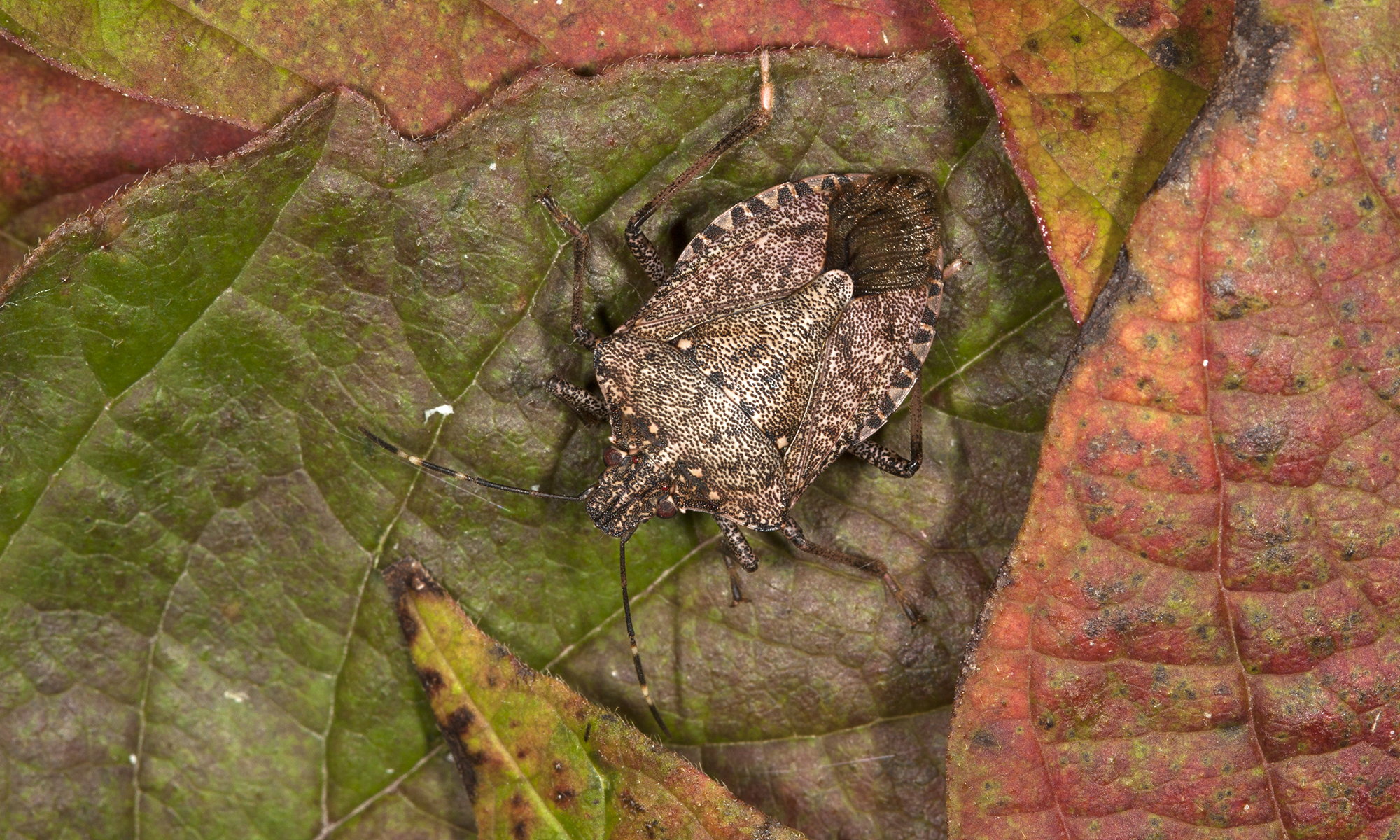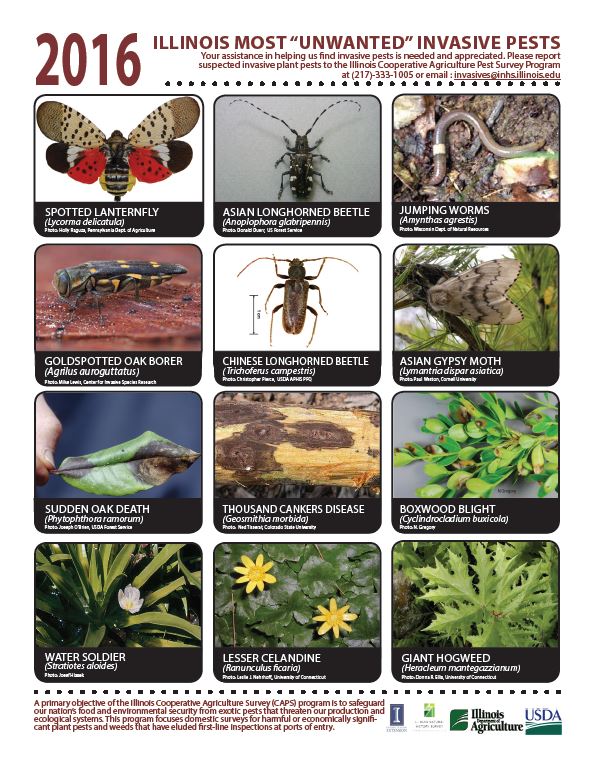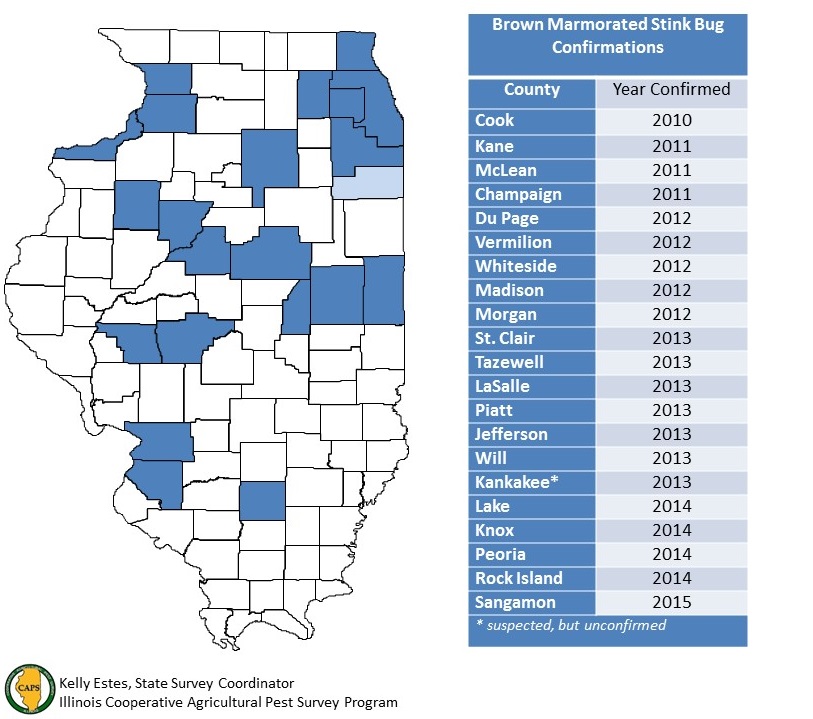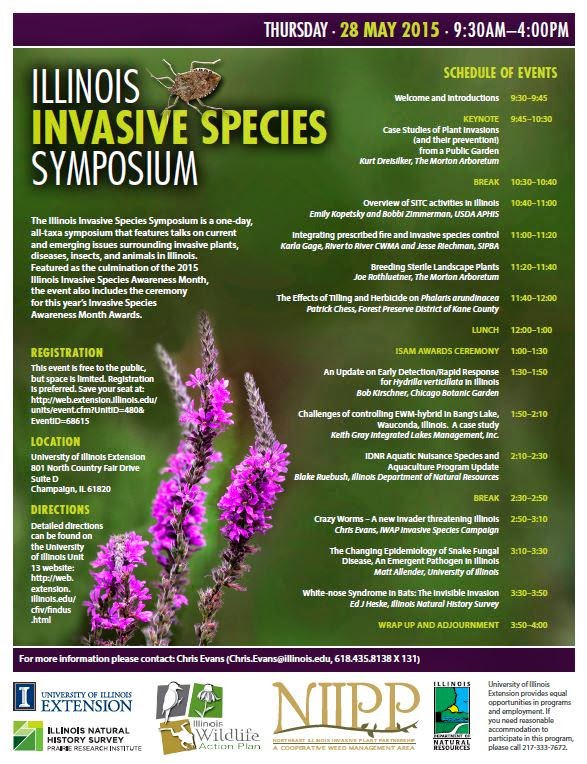February 21-27 is National Invasive Species Awareness Week. Let’s start out by introducing some of our Most Unwanted Invasive Species in Illinois!
Illinois To Drop Internal EAB Quarantine
FOR IMMEDIATE RELEASE
October 21, 2015
Illinois To Drop Internal EAB Quarantine
2015 Survey Confirms Discovery of Emerald Ash Borer in 10 New Counties
SPRINGFIELD, IL.—The state of Illinois will no longer restrict the movement of any cut, non-coniferous firewood within the state. Illinois joins Missouri, Iowa, and Kentucky in the deregulation of Emerald Ash Borer (EAB).
The 2015 survey of traps detected EAB in 10 new counties in Illinois: Madison, Mercer, Jackson, Saline, Hamilton, Wayne, Clay, Jefferson, Washington, and Bond. The addition of 10 new counties has brought the total count of confirmed counties to 60.
“The survey results this year support deregulation with nearly 60 percent of our counties confirmed positive for EAB,” said Plant and Pesticide Specialist Supervisor Scott Schirmer. “Over the past decade, the regulations and quarantines have served their purpose to slow the rate of spread and afford people time to manage for this pest. However, there comes a time when the pest is too widespread to continue to regulate, and this is our time.”
Previously EAB presence was confirmed in 50 counties, but 61 of Illinois’ 102 counties were under a state quarantine, which was intended to prevent artificial or human assisted spread of the beetle.
“Even though the state of Illinois is lifting its in-state EAB quarantine, I urge all Illinoisans to remain vigilant against the man-assisted spread of not only this pest, but all invasive species,” said Acting Agriculture Director Warren Goetsch. “Illinois will remain part of a federal quarantine, meaning firewood or other ash related products cannot travel into a state that currently has regulations. I urge people to consider the potential impacts of their actions, in general, before they move items like firewood. We’ve witnessed the impacts EAB has had on our trees and budgets, and we want to prevent introduction and spread of other current and future invasive species.”
Since the first detection of the pest near Detroit, Michigan, in 2002, the beetle has killed more than 250 million ash trees. The borer, known for its distinctive, metallic green wing color, is native to Asia. Its larvae burrow into the bark of ash trees, causing the trees to starve and eventually die. The tiny beetle often is difficult to detect, especially in newly-infested trees. Signs of infestation include thinning and yellowing of leaves, D-shaped holes in the bark of the trunk or branches and basal shoots. Each year Illinois Department of Agriculture officials submit samples from various purple EAB traps throughout the state and send them to the USDA’s Animal and Plant Health Inspection Service (APHIS) to confirm the presence of EAB.
Anyone who suspects an ash tree has been infested should contact their county Extension office, their village forester or the Illinois Department of Agriculture at (815) 787-5476.
For further information about the beetle, visit www.IllinoisEAB.com.
The Return of the Unwanted House Guest: Brown Marmorated Stink Bug
It’s the time of year when my email is flooded with reports of brown marmorated stink bugs. Yep, it’s a sure sign fall is upon us.
As the growing season winds down, the temperatures begin to cool, and the days get shorter, several insects take to hanging out on the sides of houses, garages, and window sills. While they may appear to be warming themselves in the sun, these wily little creatures are most likely scoping out a nice place to spend the winter months. The days of boxelder bugs and multicolored Asian ladybeetles are not over, but there is a new house guest in several parts of the state.
The brown marmorated stink bug has been present in Illinois for quite some time (feel free to use the search engine on the Hone, Yard, and Garden Newsletter site to read more about them), but in recent years they are becoming much more noticeable in several areas of the state and a real nuisance as well.
A great resource for homeowners is a publication from Cornell University. It’s important to remember that it is geared towards homeowners in the east. While these management strategies are applicable in Illinois, the situations requiring treatment the landscape outside the home decrease the number of BMSB home invaders has been quite small. The Unwelcome House Guest: Brown Marmorated Stink Bug–A Guide for Residents, Property Managers, and Pest Management Professionals
Currently, the known distribution of this insect in Illinois is limited. Homeowners are our primary source of information during the fall and spring. We are very interested in where these insects may be and continue to try to determine where they are in Illinois.
If you believe you have BMSB, we would be very interested in looking at it. Suspect stink bugs may be sent to Kelly Estes, 1816 S. Oak St., Champaign, IL 61820. Please put stink bugs in a crush-proof container (pill bottle, check box, etc). You can also send a photo to kcook8@illinois.edu for preliminary screening if you wish.
Emerald Ash Borer Webinar series to kick off next week
The Fall 2015 Emerald Ash Borer University webinars
will begin this Thursday, Sept. 17 at 2 p.m.
The presenter is Jill Johnson, Midwest Forestry Coodinator, with the U.S. Forest Service, Northeastern Area.
She will give an overview of the “Great Lakes Restoration Initiative”. The Great Lakes Restoration Initiative was launched in 2010 to accelerate efforts to protect and restore the largest system of fresh surface water in the world — the Great Lakes.
http://greatlakesrestoration.us/
To join the webinar, go to:
https://msu.zoom.us/j/410551924
The new Zoom webinar platform is now being used, instead of Adobe Connect. You may see a few changes in the look and functionality, but our presenters are still the same high quality!
The webinars will be recorded, and available for viewing after the presentation.
Go to http://emeraldashborer.info/eab_university.cfm for more information on EAB University.
Brown Marmorated Stink Bug Survey
Got bugs? Are stink bugs causing problems for you at your home or business?
The Brown Marmorated Stink Bug (BMSB) IPM Working Group would like to hear from you to learn more about the problems caused by BMSB and how you are tackling them via this survey.
https://www.surveymonkey.com/r/BMSBsurvey
We encourage you to take the time to fill out this simple survey if you have dealt with or are currently dealing with brown marmorated stink bugs in your area. We continue to monitor the distribution of BMSB in Illinois as well is its progression into a nuisance pest in homes and a pest of crops in Illinois.
We currently have confirmed BMSB in the following Illinois counties. We are still encouraging people to report new infestations and to contact us if you have any questions.
Please feel free to email Kelly Estes, State Survey Coordinator (kcook8@illinois.edu).
Sniffing Out Invasives
Detection dogs at their finest!
Illinois Invasive Species Symposium presentations available online
Recordings of the presentations from the 2015 Illinois Invasive Species Symposium are now available online on the symposium webpage –
http://www.invasive.org/illinois/2015InvasiveSpeciesSymposium.html
The all-day symposium featured 11 presentations on a wide range of invasive species topics and included the Illinois Invasive Species Awards Ceremony. (See the full agenda at http://www.invasive.org/illinois/2015_IllinoisInvasiveSpeciesSymposiumagenda.pdf)
Over 100 people attended the symposium in person and over 50 signed onto watch the live webcast. A direct link to the recordings – http://www.invasive.org/illinois/presentations.html.
Trees, Tools for Community Health
As we gear up for another summer season, it’s time to reflect on how our daily choices may be influenced by trees. When out shopping, you may peruse the parking lot to find precious and limited parking spaces shaded by trees. When strolling down the sidewalks and business districts, you may be drawn by the beauty of trees lining pathways, perhaps taking a break from your escapades and parking yourself on a bench in the shade of one of those trees. Enjoy the space and solitude in the shade, easily ten degrees cooler than a few short feet out in the direct sunlight.
 My own office window shaded by a large, beautiful shumard oak. Combined with overlooking a lake and blanketed by a majestic canopy of trees, it’s relaxing and honoring to have such a beautiful view, inspiring my work and personally testifying to the wonders and benefits that trees provide us. I delight in the sounds of the whispering leaves as the wind gently winds its way through the branches and cherish the songbirds that visit my window, briefly grabbing a bit of seed before flitting off to the nearest tree.
My own office window shaded by a large, beautiful shumard oak. Combined with overlooking a lake and blanketed by a majestic canopy of trees, it’s relaxing and honoring to have such a beautiful view, inspiring my work and personally testifying to the wonders and benefits that trees provide us. I delight in the sounds of the whispering leaves as the wind gently winds its way through the branches and cherish the songbirds that visit my window, briefly grabbing a bit of seed before flitting off to the nearest tree.
While these notions are romanticized and artistic, I am not the only one who expresses these thoughts. According to the Missouri Department of Conservation, employees with views of nature (including trees) report 15% fewer illnesses and feel more enthusiastic and less frustrated than those without a view outside. Another study reveals that workers without nature views from their desks claimed 23% more sick days than workers with views of nature. Let these statistics speak for themselves, relaying the physical and mental benefits of trees.
We all hear that exercise is good for our health. Sure, trees supply an element of outdoor work. Raking leaves, cleaning gutters, and even collecting branches after a storm can create aches and pains, leaving us reaching for painkillers every now and then. However, trees provide a fundamental factor in community health and well-being, far outreaching these types of inconveniences.
 Trees are linked to a variety of recreational opportunities, such as hiking, biking, wildlife viewing, increased unstructured play, and even urban hunting. People who live within one mile of a park or public open space are three times more likely to achieve recommended levels of physical activity. Tree-lined streets are more walkable, encouraging more active lifestyles.
Trees are linked to a variety of recreational opportunities, such as hiking, biking, wildlife viewing, increased unstructured play, and even urban hunting. People who live within one mile of a park or public open space are three times more likely to achieve recommended levels of physical activity. Tree-lined streets are more walkable, encouraging more active lifestyles.
According to the Arbor Day Foundation, exercising in natural environments is associated with greater feelings of revitalization and positive engagement, decreases in tension, confusion, anger, depression, and increased energy. Children and youth living in greener neighborhoods have lower body mass index. In return, areas with trees can promote reduced obesity rates and improved heart health. Trees can promote walkability, benefiting against diabetes, cancer, arthritis, high blood pressure, and heart disease.
Air quality control is another health concern, especially in urban areas. Trees filter airborne pollutants. According to the Alliance for Community Trees, urban trees in the United States remove 711,000 tons of air pollution annually, at a value of $3.8 billion. One acre of trees produces enough oxygen for 18 people to breathe each day and eliminates as much carbon dioxide from the air as it produced from driving a car 26,000 miles. In short, trees help us breathe easier, reducing asthma and other respiratory problems by removing dangerous particulates from the air.
Trees are good for the mind and body. Think of them as nature’s therapy. Patients in hospitals with nature views recover more quickly, report fewer complaints, need fewer painkillers, and exhibit increased immune function. Additionally, they are released from hospitals a day sooner than similar patients who had a view of a brick wall, attesting to the positive influence of trees and nature.
Children in tree-lined neighborhoods play outside 10% more and have lower rates of attention deficit disorder. They are better able to concentrate, increase self-discipline, complete tasks, and follow directions after playing in natural settings. According to the Missouri Department of Conservation, contact with nature helps children cultivate imagination and creativity, intellectual development, and social relationships. And it’s not only the youth that benefit from trees. Studies show that the elderly population can increase longevity when exposed to trees and natural areas.
Tree are also a natural anti-depressant. They reduce stress levels by decreasing cortisol levels, a physical indicator of stress. Park users have lower levels of anxiety and sadness after visiting parks. They also report urban forests and parks offering a place for reflective thought, resting the mind, and increasing creative thinking.
People in housing surrounded by trees report that their life issues feel less difficult, they procrastinate less, and have higher attention spans. Residents who walk near newly green vacant lots had lower heart rates compared to walking near blighted, neglected vacant lots. College students with natural views from their dorms score higher on tests. Those who commute along tree-lined roads remain calmer (lower pulse and blood pressure) and drive less aggressively than those who drive along roads with less trees.
The bottom line is trees make us happier and healthier. They encourage active lifestyles, amend air quality, boost healing and therapy, improve mental health and function, and reduce stress. Trees uplift our everyday living and the world around us. Have you had your dose of trees today?
**Special thanks to Alliance for Community Trees, the Forest Service, the Arbor Day Foundation, and the Missouri Department of Conservation for supplying research results, case studies, and facts supporting health benefits derived from trees.**
FOR IMMEDIATE RELEASE
Jennifer Behnken, Urban and Community Forestry Coordinator
Southern Illinois University Carbondale, Dept. of Forestry
Agriculture Building – Mailcode 4411
1205 Lincoln Drive
Carbondale, IL 62901
Phone: 618/435-3341
Fax: 618/453-7475
jbehnken@siu.edu
Midwest Invasive Plant Network Landscape Alternative APP
Do you get questions about which ornamental plant is considered invasive and what alternative plant options are? If so MIPN has created a great resource for you. We call it the Landscape Alternatives brochure. Within the brochure are known invasive plants sold in the ornamental trade industry with alternative species (native and non-native) provided.
This resource has actually been available for several years, and is also available as a mobile App for android and apple products. Recently we have updated this Application to include four additional invasive species (English ivy, Chinese silvergrass (Miscanthus sinensis), porcelainberry, and callery pear) along with 36 recommended alternatives to these species.
To download the App please click on this link here!
The brochure can be purchased from the MIPN website www.mipn.org
Please share this FREE resource to other individuals to limit the purchase (and spread) of invasive plants throughout the midwestern United States!
Mark Renz (President MIPN)
Registration open for Illinois Invasive Species Symposium
Join us for the second annual Illinois Invasive Species Awareness Month (ISAM) Symposium at the University of Illinois Extension office, in Champaign, IL on Thursday, May 28th from 9:30 am to 4 pm. It will be a great opportunity to learn more about what is happening on the invasive species front throughout Illinois. The event will feature talks about invasive species ranging from snake fungal disease and white-nose syndrome in bats to aquatic invasive plants. For more information see the attached announcement. The event is free and open to the public, but registration is required (see below for details). Please forward to this anyone that might be interested.
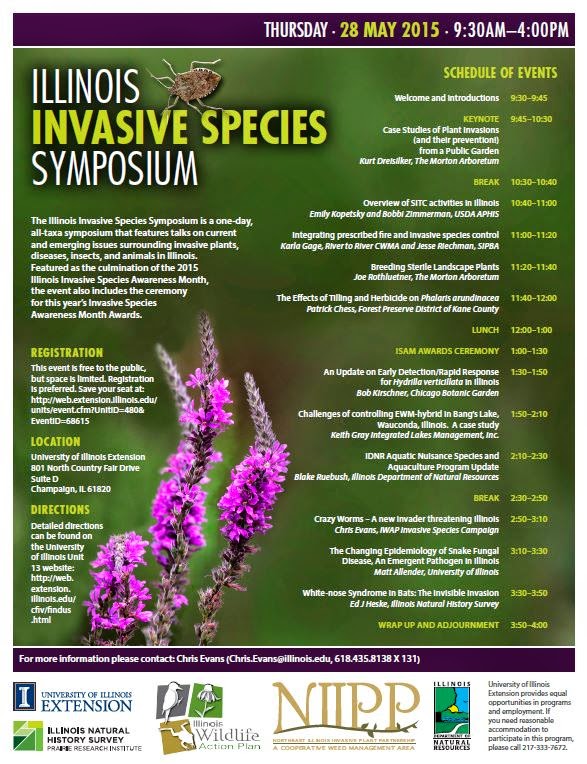
ISAM Illinois Invasive Species Symposium
May 28, 2015
University of Illinois Extension Office
801 N Country Fair Drive
Champaign, IL 61821 (Champaign County)
The Illinois Invasive Species Symposium is a one-day, all-taxa symposium that features talks on current and emerging issues surrounding invasive plants, diseases, insects, and animals in Illinois. Featured as the culmination of the 2015 Illinois Invasive Species Awareness Month, the event also includes the ceremony for this year’s Invasive Species Awareness Month Awards.
REGISTRATION
This event is free to the public, but space is limited. Registration is preferred. Save your seat at: http://web.extension.illinois.edu/units/event.cfm?UnitID=480&EventID=68615
DIRECTIONS
Detailed directions can be found on the University of Illinois Unit 13 website: http://web.extension.illinois.edu/cfiv/findus.html
